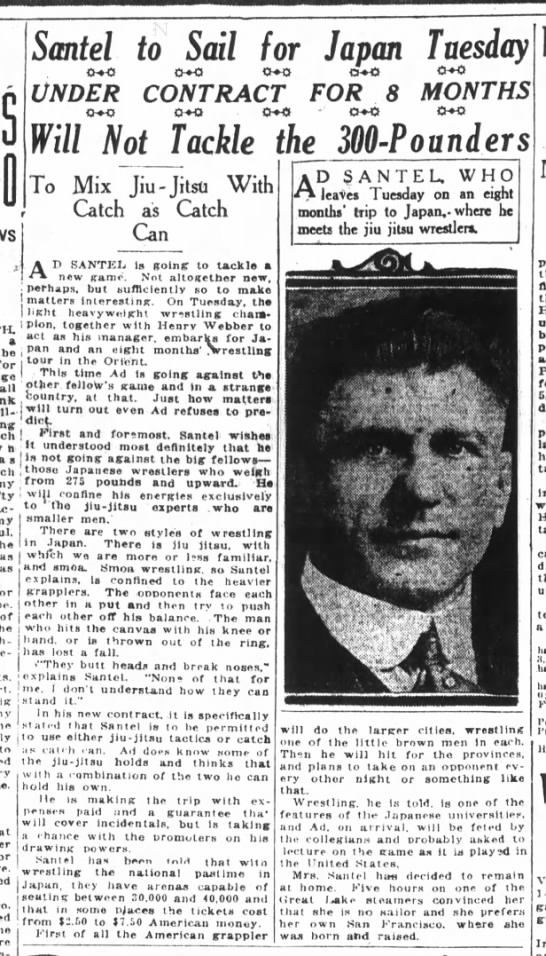
Ad Santel’s Impact on Catch Wrestling, Judo, and Modern Mixed Martial Arts: A Closer Look
Ad Santel, the German-American professional wrestler, left an indelible mark on the lineage of Catch wrestling, Judo, and modern mixed martial arts (MMA). His groundbreaking encounters and innovative approach to martial arts challenged established norms and paved the way for the evolution of these disciplines. In this article, we will explore Santel's significance to the world of wrestling, his encounters with notable figures such as Tokugoro Ito and Taro Miyake, and his impact on the development of martial arts in Japan and beyond.
Ad Santel's Early Career and Rise to Prominence
Adolph Ernst, better known as Ad Santel, was recognized as one of the greatest practitioners of Catch wrestling. His professional wrestling career spanned the 1910s, '20s, and '30s, during which he faced some of the top wrestlers of the time, including Joe Stecher, John Pesek, and Clarence Eklund. Santel's exceptional skills and tenacity led him to become the World Light Heavyweight Champion for several years, solidifying his reputation as a formidable competitor.
Taro Miyake and Santel's Pro Circuit Meetings
While researching Santel's encounters, it becomes apparent that separating fact from fiction can be challenging. One figure who features prominently in Santel's career is Taro Miyake. Contrary to popular belief, Miyake was not a resident Judo master in Seattle but rather a globe-trotting professional wrestler. He and Santel crossed paths numerous times on the pro circuit. Miyake's background was rooted in an old style of jiu-jitsu, and he was renowned for his street fighting skills. Some speculate that Miyake left Japan due to troubles with the Yakuza.
Santel's Clash with Tokugoro Ito, then Journey to Japan
One of Santel's most notable clashes was with Tokugoro Ito, a 5th degree black belt in judo. Santel, fighting under judo rules, utilized his catch wrestling techniques to defeat Ito in their first encounter. However, Ito would later gain redemption by choking Santel unconscious in their second bout, leaving the score between them at one win each.
In the early 1900s, Santel embarked on a journey to Japan at the request of a sumo promoter. Accompanied by Henry Weber, Santel sought to showcase his wrestling prowess in the land of martial arts. However, his encounters with the judo community would prove to be the most impactful.
Santel's Historic Matches in Japan
Despite the Kodokan's prohibition on its judoka competing in professional matches, Santel managed to convince four of Jigoro Kano's students to face him and Weber in Japan. The encounters took place under neutral rules, demanding judogi jackets but allowing a wide array of holds.
During these matches, Santel achieved two draws and one victory, while Weber secured two draws and one loss. Santel's triumphs and competitive performances against respected judo practitioners left a lasting impression on the Japanese martial arts scene. These encounters shattered preconceived notions and sparked a fascination with the submissions and techniques of Catch wrestling within the Japanese community.
Santel's Influence and Legacy
Ad Santel's impact on the development of martial arts, particularly Judo, cannot be overstated. His willingness to challenge established norms and cross boundaries between different styles served as a catalyst for the evolution of these disciplines. The infusion of Catch wrestling techniques into Judo sparked a new era of exploration and innovation in Japanese martial arts.
Santel's influence extended beyond his matches in Japan. His brutal style of Catch wrestling, which he likely acquired from training under Charles Olson in Chicago, led to major bouts with renowned wrestlers such as Joe Stecher, John Pesek, and his fierce rival, Clarence Eklund, in the world of Catch wrestling. Santel's reputation as a formidable competitor and his unyielding determination left a lasting impact on the sport.
In addition to his in-ring accomplishments, Santel's encounters in Japan and his interactions with the judo community had a profound effect on the martial arts landscape. His performances captivated the Japanese audience, inspiring a wave of interest in catch wrestling and prompting Japanese fighters to travel to Europe to learn catch wrestling techniques at schools like Billy Riley's school in Wigan, UK. Some of Kano's expelled judo challengers even followed Santel to the United States to train with him, further contributing to the cross-pollination of techniques and ideas between Catch wrestling and Judo.
Today, Santel's legacy lives on in the lineage of Catch wrestling, Judo, and modern mixed martial arts. His willingness to push boundaries, challenge traditional martial arts norms, and introduce new techniques opened doors for future generations of fighters and contributed to the development of the dynamic and diverse martial arts landscape we see today.
In conclusion, Ad Santel's significance to the lineage of Catch wrestling, Judo, and modern mixed martial arts cannot be overstated. Through his encounters in Japan, his clashes with notable figures like Tokugoro Ito and Taro Miyake, and his unyielding commitment to pushing the boundaries of martial arts, Santel left an indelible mark on the world of combat sports. His innovative approach, fierce competitiveness, and willingness to challenge the status quo continue to inspire and shape the evolution of martial arts today.
Let's honor and recognize Ad Santel's contributions to the sport and his enduring legacy. His impact on the world of wrestling and martial arts will forever be etched in history, and his pioneering spirit serves as a reminder to continuously push the boundaries and embrace innovation in our pursuit of excellence.
(Very special thanks to Mark Hewitt and C. Nathan Hatton for adding important details.)


